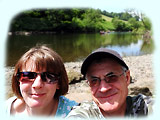What is Geocaching all about then?
We enjoy Geocaching - a pastime using Sat Nav and the
internet to find hidden items around town and country.
It's best described as a fun and educational recreational
activity; a treasure hunt that uses a GPS receiver or, more commonly
these days, a smartphone
+ app
to find, typically, a box with goodies in. See the entry on Wikipedia
for a full description.
 Here at micbinks we contribute to the geocaching
community on the global GPS cache hunt website: www.geocaching.com
- check us out under our ID which is, of course, 'micbinks' - and
we enjoy searching out locations both locally and when on holiday. Here at micbinks we contribute to the geocaching
community on the global GPS cache hunt website: www.geocaching.com
- check us out under our ID which is, of course, 'micbinks' - and
we enjoy searching out locations both locally and when on holiday.
Geocaching can be environmentally friendly - 'cache-in
trash-out' - where participants clear rubbish from the geocache area
(like The Wombles?). It's a family friendly pastime and healthy
for both mind and body, what with all the walking/searching/thinking
that's required. And it's highly educational - knowledge of
navigation, topography, land use, GPS, mapping and the grid system is
gained (oh, and where the nearby pubs are!). As a responsible
pastime, accepted practice guidelines are published by the
geocaching community.
|
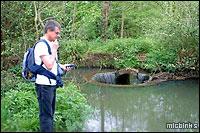
GPS tracking a cache...
|
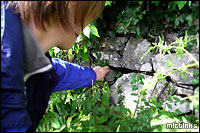
Finding a cache...
|
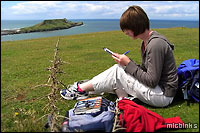
Logging a cache
|
So how do you go Geocaching?
 Not so long ago a handheld Sat Nav receiver (image left)
was required for geocaching, but now you'll already have suitable
hardware - yes, your smartphone! You'll need to install a
geocaching app plus map for offline use and open an account with Groundspeak's
geocaching.com, the geocachers gateway. A basic account is
free; a paid premium member subscription (currently £24.99/yr) provides
access to more caches and more functions. You'll be able to view
geocache details which includes a description, photos, previous
finders' logs, and, of course, the vital cache coordinates.
Caches can be searched for by area, viewed in a list and located on the
map. Once you've read and noted some juicy caches to attempt
(they have difficulty and terrain ratings) in your chosen area, just
save the caches in the app for offline use and you're off! It's
probably best to start with straightforward rural caches approached on
foot or cycle as there's less people about (called muggles in geocache
speak!) to contend with. Not so long ago a handheld Sat Nav receiver (image left)
was required for geocaching, but now you'll already have suitable
hardware - yes, your smartphone! You'll need to install a
geocaching app plus map for offline use and open an account with Groundspeak's
geocaching.com, the geocachers gateway. A basic account is
free; a paid premium member subscription (currently £24.99/yr) provides
access to more caches and more functions. You'll be able to view
geocache details which includes a description, photos, previous
finders' logs, and, of course, the vital cache coordinates.
Caches can be searched for by area, viewed in a list and located on the
map. Once you've read and noted some juicy caches to attempt
(they have difficulty and terrain ratings) in your chosen area, just
save the caches in the app for offline use and you're off! It's
probably best to start with straightforward rural caches approached on
foot or cycle as there's less people about (called muggles in geocache
speak!) to contend with.
 Follow the electronic compass or map arrow, keeping in
mind that, unless you have wings, you can't always navigate 'as the
crow flies'. When you get to within, say, 10 metres, start
looking around for any clues as to where the geocache might be
hidden. It helps to keep in mind the cache container type you're
looking for, description, previous finders' logs and the additional
hint. This often gives it away with clues such as 'bottom of
fence post', 'under seat', 'hole in wall', etc, so be careful not to
spoil the fun! Follow the electronic compass or map arrow, keeping in
mind that, unless you have wings, you can't always navigate 'as the
crow flies'. When you get to within, say, 10 metres, start
looking around for any clues as to where the geocache might be
hidden. It helps to keep in mind the cache container type you're
looking for, description, previous finders' logs and the additional
hint. This often gives it away with clues such as 'bottom of
fence post', 'under seat', 'hole in wall', etc, so be careful not to
spoil the fun!
 When you've (hopefully!) found the cache, open the
container and fill in the paper log with the date and your geocaching
name. Larger caches contain small items you can swap if you
wish. Seal the lid and carefully replace the geocache back where
you found it, covering with sticks, stones, etc. ready for the next
geocacher. If you wish, take a photo of something interesting
nearby, taking care that it doesn't reveal the hiding place. When you've (hopefully!) found the cache, open the
container and fill in the paper log with the date and your geocaching
name. Larger caches contain small items you can swap if you
wish. Seal the lid and carefully replace the geocache back where
you found it, covering with sticks, stones, etc. ready for the next
geocacher. If you wish, take a photo of something interesting
nearby, taking care that it doesn't reveal the hiding place.
The final stage is to log your find(s), either from within the
app or on geocaching.com: log in, browse to the relevant geocache page
and add a sentence or two describing your find (try to make it
interesting) plus upload your photo if you took one. And you're
done!
So who places geocaches in the first place? Why, other
geocachers of course! Here's some we've hidden:
GC1FCY1 - One, Two, Three, FORE!
GC1T6HC - Jack & Jill went up the hill...
GC1W156 - A Sussex High
Let's look at one of
our geocache finds...
|
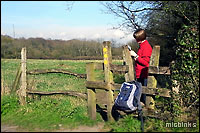
It's gotta be around here somewhere!
|
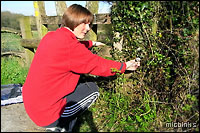
Ah, what's this buried in the Ivy?
|
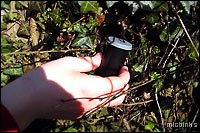
Got it!
|
Now, if we haven't put you off(!), read on for more on
Geocaching...
Cache types
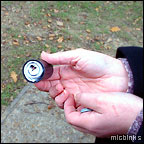 The most popular is the micro-cache, a 35mm
film pot placed as a stand-alone cache. An advancement on this is
the multi-cache which necessitates finding a number of caches each
giving a part GPS coordinate to note for the final cache coordinates. The most popular is the micro-cache, a 35mm
film pot placed as a stand-alone cache. An advancement on this is
the multi-cache which necessitates finding a number of caches each
giving a part GPS coordinate to note for the final cache coordinates.
Other geocaches require the solving of simple - or involved -
clues such as noting dates on, say, a building, notice or gravestone
then using these numbers to work out the coordinates by following a
given formula. Now this may sound like too much trouble, but once
you've tried one you'll find it's quite straightforward and a lot of
fun, especially for the kids. Some can involve a trail; the most
interesting can take you round a historic location, for example.
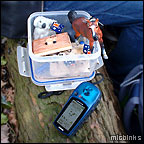 The larger lunch box caches
contain small items to swap, the idea is one item is taken and one left
which is noted in the cache and online log. Items thus travel
from cache to cache, often great distances and overseas too. The
next stage on from this are Travel Bugs where particular items are
tracked as they travel around the country - or the world! Now,
where's that tiny tatty teddy auntie gave me all those years ago... The larger lunch box caches
contain small items to swap, the idea is one item is taken and one left
which is noted in the cache and online log. Items thus travel
from cache to cache, often great distances and overseas too. The
next stage on from this are Travel Bugs where particular items are
tracked as they travel around the country - or the world! Now,
where's that tiny tatty teddy auntie gave me all those years ago...
Other types of geocaches include:
Mystery caches - puzzles that need to be solved to determine the
coordinates.
Earthcache - educational location that people can visit to view a
unique geoscience feature on-the-ground.
Adventure Lab caches - the latest cache type; an outdoor virtual
scavenger hunt that follows a story.
 See all cache types here See all cache types here
Container types
The most common is the 35mm film pot, but they can vary from the very
small nano with just enough room for a log strip, to a lunch box or
even bucket sized containing swaps. In many areas containers are
put in a camouflaged ammo type bag to keep the rain out (and make them
harder to spot!). The smaller containers are sometimes magnetic
so they can be attached to metal objects. Nanos can be
particularly challenging geocaches to find, the blighters!
Muggles – what are they then?
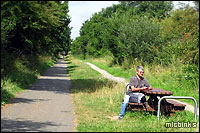 One term you'll often come across is that of
the dreaded muggle, a term derived from the Harry Potter movies.
A muggle is an innocent non-caching member of the public who may
unknowingly thwart your attempt at locating a cache. Most cachers
try to avoid raising the suspicions of the public at large when looking
for caches as there's a chance they may think a geocacher is up to no
good. A persistent muggle is the worst, one who just won't move
from the location you wish to search, such as someone sitting on the
park bench right where you suspect the cache may be. Most
frustrating! One term you'll often come across is that of
the dreaded muggle, a term derived from the Harry Potter movies.
A muggle is an innocent non-caching member of the public who may
unknowingly thwart your attempt at locating a cache. Most cachers
try to avoid raising the suspicions of the public at large when looking
for caches as there's a chance they may think a geocacher is up to no
good. A persistent muggle is the worst, one who just won't move
from the location you wish to search, such as someone sitting on the
park bench right where you suspect the cache may be. Most
frustrating!
Left. No muggles in sight - yet - along this
disused railway cycle trail as Mike logs a find.
Look out for the (usually) helpful cachers' trail when within
spitting distance of the geocache you're searching out. This
provides tell-tale evidence that the geocache is nearby, such as
downtrodden vegetation or unnaturally positioned stones. But also
be aware of a false cachers trail, indicating others have been
looking... in the wrong place!
Let's look at some
unusual geocaches we've found...
|
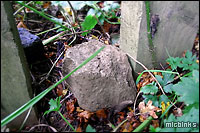
We're looking right at the cache...
|
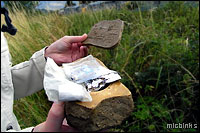
...yep, it's within that dummy stone!
|
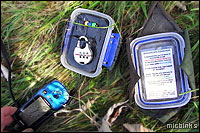
Puzzle solving required to unlock padlock
|
Geocache equipment and software
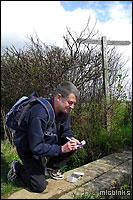 Generally all you need is a smartphone,
geocaching app and online access. When choosing a new smartphone,
we suggest picking one that has some degree of water resistance and
ruggedness. This is well worth the extra cost as however careful
you think you'll be, it's inevitable it'll get rained on /
dropped / generally knocked about in such an environment. Fitting
a knobbly phone case helps with grip and offers further knock
protection, and a screen protector is a no brainer - it's certainally
saved our screen while geocaching. Also a power bank may just
save the day when the battery runs out before completing the day's
caches! Generally all you need is a smartphone,
geocaching app and online access. When choosing a new smartphone,
we suggest picking one that has some degree of water resistance and
ruggedness. This is well worth the extra cost as however careful
you think you'll be, it's inevitable it'll get rained on /
dropped / generally knocked about in such an environment. Fitting
a knobbly phone case helps with grip and offers further knock
protection, and a screen protector is a no brainer - it's certainally
saved our screen while geocaching. Also a power bank may just
save the day when the battery runs out before completing the day's
caches!
If the bug bites big then a dedicated handheld Sat Nav device
can be considered, with more advanced Ordnance Survey mapping installed
(subscription required). Finally, using your good old existing PC
or laptop facilitates studying caches in detail and logging your finds
(or no finds!) on geocaching.com.
Other useful items to take on your geocaching adventures are:
gardening gloves for rummaging around all those prickly plants, small
tweezers for extracting log strips, a small telescopic rod with
magnetic end, and a poking stick as you'll never find one nearby when
needed! Oh, don't forget a pen too.
Looking at some
typical cache hidey holes...
|
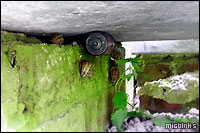
This was underneath a horse trough
|
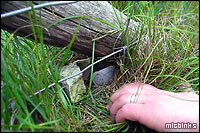
The ubiquitous 'bottom of fence post'
|
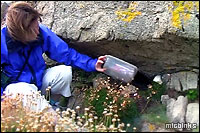
A struggle to extract this one from the rock
|
Geocaching has social aspects too. Apart from the social
network provided by the website, many local groups of geocachers get
together, say, once a month in a pub; automatic news of upcoming local
meets can be notified.
It's an international hobby with many overseas travellers
finding and logging caches in countries they're visiting. Expect
to see log entries from overseas visitors, particularly in popular
tourist areas. We've searched out some rather scenic caches over
the years while touring in Gower,
the Cotswolds, Cornwall, Isle of Wight, Wiltshire, Kent Pembrokeshire, the Wye Valley, Dorset's Jurassic Coast,
Buckinghamshire
and Snowdonia.
Here's some 'guardians
of the cache'...
|
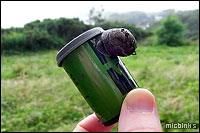
This snail was gripping tightly to the cache
|
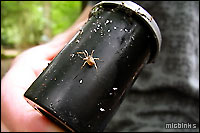
Well, the spider didn't put up much fight!
|
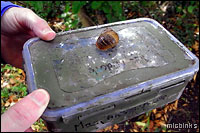
Some guard - this guy was asleep on the job!
|
Terminology
Like many hobbies, geocaching has its own language and abbreviations,
here's a few common ones:
GPSr Global Positioning System receiver (AKA a Sat Nav device)
Spoiler - a give-a-way to the cache location, maybe a photo or text
that's too specific
Stealth - trying not to draw too much attention to yourself while
caching
SL - signed log
DNF - did not find
FTF - first to find
T4TC (or TFTC) - thanks for the cache
TNLN - took nothing left nothing
TB - Travel bug
CITO - cache in trash out
stickouflage - unusual pile of sticks covering a geocache
Here's some Geocaching resources
you may find useful:
Groundspeak's international geocaching website
UK reviewer 'Graculus' (now archived) site of geocaching resources
c:geo - Android geocaching app
(and the one we use on our smartphone)
Swiss Army Knife
(GSAK) - geocaching and waypoint management tool for PC, processes GPX
file for mobile device
Cachemate
- geocaching database with hint decoder
Memory-Map
- mapping software for PC or smartphone
Google
Earth - uses KML overlays to view geocaches and trails
© micbinks 2010 - 2025. If you wish to
reproduce any of our original content please seek our permission first.
Page last updated Aug 2021
|
